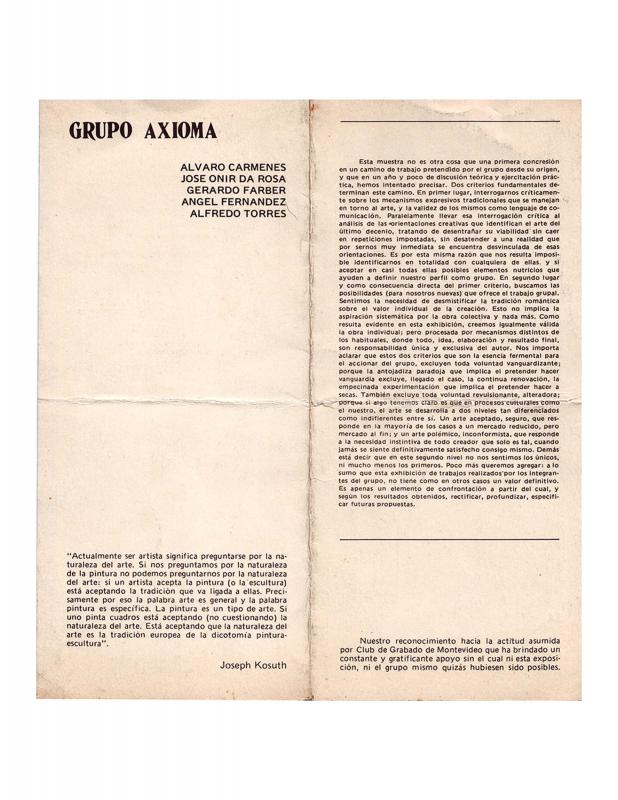In just two years, the Octaedro group generated intense activity focused on the experimental artistic practices in Uruguay, and surprisingly as well, forms of rebellion against the prevailing difficult sociopolitical circumstances. The group was formed at the end of 1978, during the final stage of the military dictatorship (1973−85), defying interpersonal isolationism promoted by the regime. The group was formed shortly before the emergence of other artistic groups such as Los Otros and Axioma. [Please refer to the ICAA digital archive for the following texts on the subject: “Una narrativa sobre el arte uruguayo en dictadura. Las instalaciones y estrategias conceptualistas de los grupos Octaedro, Los Otros y Axioma,” by May Puchet (doc. no. 1251139), “AXIOMA” (unsigned) (doc. no. 1250717), “4 Ambientación grupo Los Otros,” by the group Los Otros (doc. no. 1251116) and “Grupo Axioma,” by Grupo Axioma (doc. no. 1250744)], which initially consisted of Fernando Álvarez Cozzi (b. 1953), Carlos Aramburu (b. 1951), Carlos Barea (b. 1954), Juan Carlos Iglesias (b. 1956), Miguel Lussheimer (b. 1961), Abel Rezzano (b. 1936), and Carlos Rodríguez (b. 1951); they were mostly from the CEA (Centro de Expresión Artística), directed by Nelson Ramos (1932–2006).
After its inaugural showing at the Uruguayan Cinematheque [Please refer to the ICAA digital archive for the text on “Octaedro. Expone Grupo Octaedro,” (unsigned) (doc. no. 1260081)], there was a second exhibition at the Cultural Alliance of Uruguay and the United States where both spaces were receptive to new projects. This meant both an instance of group progress and advancements as well as a new and active project for artistic media. Octaedro exhibited four dolls or four soft human-shaped forms lined with dark plastic “skin” arranged in a cross, which days before had been toured throughout the city as figures made to metaphorically assimilate the bodies of the disappeared, similar to the memory walls of Argentina. The exhibition included slides of anonymous faces and photographs of the group’s urban gallery and their work. They affirmed a group voluntary realization of the artistic process linked to its environment. The text of the catalogue asserted “the act of thinking” as a rupture from the predominant apathy and proposing a reconstruction of its subjects as thinking and acting as individuals, and not merely subjects within a massively manipulated society. In the catalogue brochure, there is a quotation by the psychoanalyst and researcher Frederick A. Weiss, taken from his writing for the American Journal of Psychiatry in 1961, from his article, “Dynamics and Therapy of Auto Alienation.”





